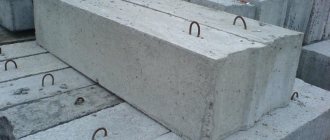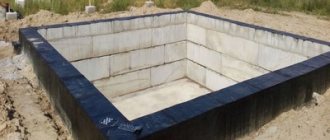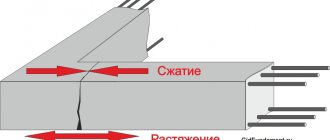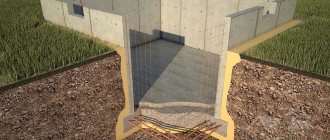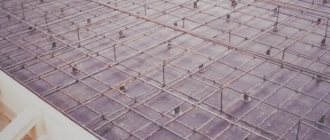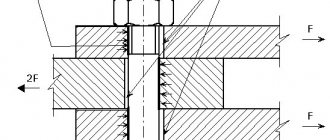Installing a strip foundation for a fence is probably the best solution. After all, this design is universal. You can install any wall materials on it: light (from corrugated sheets, mesh, boards and others) and the heaviest (from bricks or blocks), and at the same time it can cope with loads perfectly. In addition, the tape is a barrier structure through which it will not be possible to penetrate under the fence from below.
Types of strip foundation
There are two types of strip foundation:
- Monolithic , when the tape consists entirely of concrete. This is the most expensive option, but also reliable. It is often used on heaving soils.
- Columnar with crossbars between the supports. Both elements are made monolithic, but only the pillars are sunk into the ground. This option is simpler in terms of complexity and will cost less.
Materials
There are also two options: a foundation made of concrete or stone. The second position is called rubble concrete, because during the construction of the structure, rubble stone is used, laid on a cement mortar that holds it together. A monolithic structure will be more expensive, although in terms of manufacturability it is simpler.
It is necessary to add that the foundation for a brick fence made of rubble stone must be made with a fastening mortar of a grade not lower than M 300. It is impossible to carry out reinforcement in this design, so the strength of the structure is not so high as to withstand heavy wall materials.
Excavation
Small trenches are dug by hand using a bayonet shovel and a crowbar. The roots in the ground are cut with an ax. For a long foundation, a large volume of excavation will be required, so a mechanized method using excavators is used.
In any case, the bottom of the pit is cleaned to the design level; the procedure is done manually. The height of the crushed stone and cement backfill is taken into account when calculating the depth of the trench in order to maintain the required dimensions of the concrete strip.
Construction of a trench and crushed stone base
Gravel is poured into the bottom of the trench.
In the first case, a trench is dug along the width so that it is possible to make wooden formwork for concrete. The second option involves pouring the mixture directly into a trench, the width of which corresponds to the calculated size of the tape. Both options have a right to exist.
At the bottom, make a bedding of sand (5 cm), crushed stone (10 cm). The compacted cushion strengthens the base under the sole and increases its density. Serves as drainage for drainage of groundwater, prevents soil shifting and heaving.
Dimensions
The depth of pouring the strip foundation under the fence is determined by the level of soil freezing in the area. The lower part of the structure must be at least 20 cm below the level. In this way, the issue of the adverse effects of soil heaving on the base of the fence is resolved.
As for the width, the width of the wall material used is taken into account.
- If a brick is used for the structure, laid transversely, and its length is 25 cm, accordingly the width of the foundation should be slightly larger - 30 cm.
- If concrete blocks with a width of 20 cm are used, then the width of the base should be 25 cm.
- If preference is given to a strip foundation for a fence made of lightweight materials, then the diameter of the pipes, which are the racks for the structure, is taken into account when calculating its width.
In the latter case, one remark must be made. Typically, to construct a fence from corrugated sheeting or mesh, profile pipes with a cross section of 40x40 or 50x50 mm are used. This does not mean that the width of the foundation will be only 6 cm. Such a structure will not even withstand soil heaving. Therefore, there is a minimum size for the width of the structure to be laid - 20 cm.
Construction of a trench and soil foundation
A ditch for the foundation is made to a depth equal to its height, and 15 cm is added under the sand cushion. The soil that will be located under the foundation should not be exposed to underground sources or freezing.
To create a sand bed, you need to use medium-sized sand. After filling the trench, it must be compacted well. The width of the trench at the bottom is 200-300 mm greater than the width of the foundation.
This is necessary for arranging the formwork and laying the cushion. On dense soils, when arranging a rubble concrete base, formwork can be omitted.
Construction rules
Building a strip foundation for a fence with your own hands is not a problem. The main thing is to strictly follow the sequence of operations. Therefore, the question of how to do it correctly is the most important one here.
Preparation
All construction processes carried out on the ground begin with markings. It is necessary to place pegs with strings stretched between them along the entire perimeter of the site. The installation locations for gates and wickets must be marked. Below are step-by-step instructions.
- A trench is dug along the entire marking, taking into account the dimensions of the foundation structure.
- The bottom is filled with crushed stone and sand. Each layer is 5-7 cm. This is a pillow for the structure.
- The formwork is being installed. If the soil on the site is strong (clayey), then it will be enough to build the formwork above the soil surface. If the soil is loose (sandy), then it is better to install the formwork to the full depth of the structure.
- A reinforcing frame made of metal reinforcement with a diameter of 8-10 mm is installed inside the trench. The frame must be double-row. Install it on supports, for example, bricks, so that it is completely inside the concrete solution.
This completes the preparation for pouring the strip foundation for the fence.
Pouring concrete
Before you make a strip foundation with your own hands, you need to be aware that this is a large amount of concrete work. Especially if the plot is large. Therefore, it is better not to mix concrete by hand. It is recommended to either buy a ready-made solution or rent a concrete mixer. Because the quality of the final result is determined by the continuity of pouring the concrete strip. In this case, several workers will be required to ensure the reception of the material or its preparation.
The main requirement for the concrete mass is to remove air from it that gets there during the preparation process. Therefore, you will have to arm yourself with a vibrator and walk through the entire structure with this tool.
In principle, we can assume that the strip foundation under the fence was poured with your own hands. All that remains is to wait for it to gain its brand strength. After 7 days the formwork is removed, after 28 you can begin to build the fence.
Main problems during construction
On a site with a slope, the tape is broken into parts and poured separately.
Before pouring the tape under the fence, you need to take into account the topography of the land plot. For construction on a slope, the tape is divided into separate sections, which have different heights in relation to each other. A level is used for marking; corners and turns are marked using a theodolite.
Problems will appear if the characteristics of the soil and its ability to heave have not been taken into account. During construction, it is necessary to compact the base under the concrete strip to avoid shifting during operation.
From corrugated sheets
The technology for constructing a strip foundation for a fence made of corrugated sheets has distinctive features that are associated with the installation of pipes. What you need to pay attention to:
- Markings are made around the perimeter to indicate where the pipes will be installed. Depending on the thickness of the profiled sheet used, the distance between the posts varies between 2 - 3 m.
- In them, boreholes are made with a garden drill to a depth below the freezing level of the soil.
- A trench 15-20 cm deep is dug between the wells.
- Pipes are inserted into the wells, pre-cut to the height of the fence, taking into account the buried part. The racks must be coated with bitumen mastic.
- The wells are being filled with concrete.
- After which a trench is poured into which either fine crushed stone or coarse sand is first poured. The thickness of the pillow is 5 cm.
- If there is a need to make a foundation with a plinth, then formwork is installed on top of the ground.
There is no need to wait a long time for the concrete solution to dry. The design of the fence on a strip foundation made of profiled sheets is lightweight, so it does not create a large load on the base.
Application of rubble concrete
The construction of a rubble concrete foundation differs from the construction of a monolithic structure in that the trench is filled with coarse filler. You can use stone, old broken brick, and other available building materials. Then a liquid solution of sand and cement is poured. This foundation technology is most often used in private housing construction.
Features of the work:
- filling the trench 30 cm with stone;
- pouring concrete mortar above the stone filling level.
When filling, it is necessary to ensure that the mixture fills the voids formed between the backfill. After completion of the work, the base must be protected from freezing and rapid drying.
From stone
In principle, it is necessary to approach the installation of a strip foundation under a stone fence from the position of a monolithic model.
All processes related to preparation are carried out in exactly the same way. Only the reinforced frame is missing. Pouring the concrete mixture begins after the trench is filled with stones.
It is better to put large boulders down. The solution is prepared liquid. They fill the first row of laid stones, then medium-sized blocks are laid on them, which is also filled with concrete mixture. And so on until all the trench and formwork are filled. There is a technology where stones are laid on a rigid fastening mortar based on cement and sand. It is more complex than described above, because you will have to adjust the stones to each other, taking into account their sizes and abutment planes.
It should be noted that the foundation for a fence made of corrugated sheets or other lightweight materials can be constructed from rubble stone. To do this, you will first have to install the racks and fill them with concrete, and only then throw stones into the trench and fill them with mortar. It is better to carry out the second operation the next day, when the solution in the wells has set well.
How to prepare concrete mortar yourself
The quality of the base largely depends on the approach to preparing the solution and pouring it. For example, it is recommended to first make a mixture of “dry” sand, crushed stone and cement, and only then add water in limited portions, controlling the density of the mixture. The approximate ratio of materials is 1:1.6:3.3 (cement, sand, crushed stone) for class B25 concrete (in the old regulatory documentation, grade M300).
Peculiarities:
- The exact figures for the volume of water depend on the moisture content of the sand, but not more than 70% of the cement mass.
- High-quality mixing of materials is possible only with a mechanized method, using a concrete mixer.
- It is optimal to carry out work at temperatures above plus 5°C or in a warm room, otherwise the concrete will turn out to be fragile.
It is better to mix waterproofing additives with water before pouring them into a concrete mixer. Thanks to this approach, the composition is evenly distributed throughout the volume. It is also recommended to mix the fiber in the mixing water until the mass is wetted and evenly distributed.
At an ambient temperature of +20°C, concrete of class B25 (grade M300) begins to set within an hour. In hotter weather the process happens faster.
It is advisable to pour concrete after 15-20 minutes of mixing. Later, the setting reaction begins and it will be more difficult to obtain a strong monolithic structure. The deeper the base lies, the more important it is to lay the mixture in layers, using vibration equipment to remove voids and air bubbles (concrete shrinks by 10-20%).
Recommendations
After installing the foundation, it is covered with a layer of roofing material so that moisture is not transferred to the structure of the pillars, brick or masonry. When concreting metal supports, their lower part is coated with resin and wrapped in two layers of roofing felt or roofing felt to prevent rust.
The formwork is placed so that the reinforcement does not reach the foundation walls by 5 cm. Reducing the gap will lead to corrosion of the frame inside the base. Refusal of reinforcement will result in deflection of the foundation under load.
Construction cost
The price of the structure depends on the materials used and construction conditions. On average, 1 meter of fencing costs 10-20 thousand rubles when doing the work yourself, taking into account facing and consumables. To save money, you should choose cheaper materials. An excellent solution would be a combination of corrugated sheets with decorative bricks. If you have a large budget, the fence can be built entirely from brick with the use of decorative wooden inserts or artistic forging elements.

